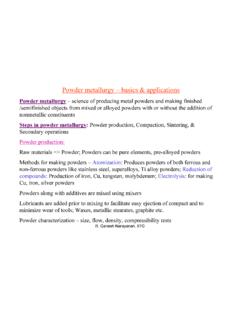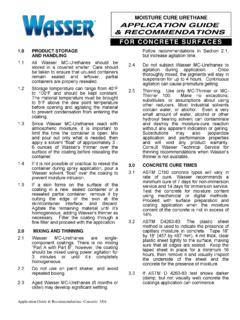Transcription of Profile calculation - tokugawa-gears.com
1 Profile calculation This chapter will cover the most common calculations that serve to define the hob tooth Profile . These formulae are becoming more and more historical in the sense that nobody calculates by hand any more. All of these calculations have now been programmed in specific computer calculation software. However, if you are interested in understanding the methods and concepts behind these calculations more deeply, the formulae given in this article may be of use. Normal Profile The normal Profile is a Profile which does not undergo any particular modifications such as protuberance, semi topping or other corrections in form. We must also consider that the rack of reference has its pitch line tangent to the theoretical pitch diameter of the gear and that therefore the pressure angle is the nominal angle of the gear.
2 It is important to underline this because later on we will examine hobs with lowered pressure angles which generate the desired Profile even though the tooth flanks have a different inclination from the nominal inclination of the gear. If we imagine that we must hob a gear with: module m pressure angle 0 circular thickness S0 dedendum hf addendum h0 pitch diameter d0 the hob must have the addendum: hkw = hf The tooth thickness on the pitch line Sw must be equal to the tooth circular thickness which in turn is equal to the pitch minus the tooth circular thickness. wvSSZdS= =000 The inclination of the hob tooth flanks is equal to the pressure angle 0 . If the gear is not topping or semi-topping, the total depth Hw must be greater than the total gear tooth depth. fkwhhH+> Figure The fact that the hob tooth Profile depends on the rake angle, which is also known as the cutting angle, has been previously mentioned.
3 It is the angle that the cutting face forms with the plane on which the hob axis lies (in the case of grooves being parallel to the axis). We have also already seen that in the vast majority of cases this angle is zero degrees. That means that the hob axis lies on the resharpening plane. The fundamental reason for this choice is that only in this way can the hob Profile remain constant after resharpening. Another important reason is that to resharpen hobs which have a rake angle other than zero degrees, it is necessary to position the grinding wheel out of axis by a distance that is not always the same but depends upon the real hob diameter as per the following formula: DaDatg22/== In the event of a positive the grinding wheel will be positioned under centre whereas in the event of a negative the grinding wheel will machine above centre. See figure Figure The value a therefore has to be calculated each time according to the real hob diameter.
4 A positive rake angle is used when it is necessary to cut particularly soft material such as aluminium or very malleable steels and when the hobbing machines used cannot run at high cutting speeds. With a positive rake angle the strain on the cutting edge is reduced and its cutting action improves but at the same time the cutting edge becomes weaker as the cutting force which is always perpendicular to the cutting face surface is in an unfortunate direction in that it tends to chip the cutting edge itself. The fact that the cutting force decreases also causes crater-type wear on the resharpening face of the tooth to form more slowly but unfortunately it is closer to the cutting edge and so increases the possibility of premature chipping. The dynamics of chip formation is comparable to those that we would have on a tool with a single tooth. See figure Figure The opposite applies to a negative angle.
5 In this case the tooth becomes stronger, crater-type wear forms more quickly but further back and the cutting edges are to a certain extent protected. A large negative rake angle is usually used for skiving-type carbide hobs which are used to finish gears that have already been heat treated. A hob produced with a rake angle other than zero must be designed and built with a pressure angle which is not equal to the normal pressure angle of the gear. The formula that is used to calculate the hob pressure angle is the following: tgxtgtgtgonon = 1 Where: 1on = hob pressure angle on = normal pressure angle of gear = rake angle x = side relief angle When producing a new hob, the plus sign is considered for positive rake angles and the minus sign for negative rake angles. Figure The interference problem When two gears mesh, there may sometimes be a problem of interference as the tooth tip edge of one gear may interfere with the tooth base of the other, making its revolution impossible or precarious.
6 Not even special cases like the meshing of a gear and a rack a gear with an infinite number of teeth - are immune to this phenomenon. If we therefore consider the teeth of a hob to be a rack, the interference problem may occur in certain circumstances, resulting in an undercut at the tooth base. (see figure ). Figure To a certain extent this fact may be considered positive as regards tooth geometry as the undercut is like a kind of widening which is normally achieved by protuberance and it makes the finishing operation easier. If the undercut is too big, however, the active Profile is reduced to the point where the meshing line between the gears is also considerably reduced. Nowadays gearboxes are smaller than in the past although they transmit relatively high levels of power. Long meshing lines with the longest possible active Profile are therefore required.
7 The start of the active Profile (SAP) is on a diameter which is very close to the root diameter and therefore undercuts generated by interference are not tolerable. Another serious problem is the fact that in the zone of interference, more material is removed by each tooth, the chip thickness increases and more strain is generally put on each single hob tooth. The phenomenon of interference between two gears depends on the pressure angle, on the transmission ratio and on the addendum to be applied on the gears. If we consider normal dimensions where the gear addendum is equal to the module, mkh =0 , with k=1 and for hobs where Z1 is infinite, where: 012=ZZ, it is possible to use the diagram in Figure to identify the minimum number of teeth which generate interference that would enable the hob to be designed without protuberance.
8 Hobs with lowered pressure angles First of all a few introductory remarks are required. On the hob in particular the module and the pressure angle are conventional values which may be adjusted within ample limits without substantially influencing the workpiece produced. Figure On the hob in particular the module and the pressure angle are conventional values which may be adjusted within ample limits without substantially influencing the workpiece produced. Normally the pitch diameter of the gear is chosen as the rolling circle. The operating pitch diameter is therefore made to coincide with the nominal pitch diameter of the gear but this is not obligatory. In theory it is possible to choose any diameter on the gear as the operating pitch diameter that is as a circle on which to roll It is sufficient to consider the values that derive from this choice, namely the pitch value and consequently the module, the new pressure angle and the new helix angle.
9 Figure shows both a standard gear and next to it the same gear where a smaller pitch diameter and then a larger pitch diameter have been considered. Figure D0 = nominal pitch diameter (a0 = nominal pressure angle) D01 = lowered pitch diameter (a01 = lowered pressure angle) D02 = increased pitch diameter (a02 = increased pressure angle) Let us take the example of a straight-toothed hob with the following nominal data: m = 2 mm ; Z = 30 ; 0 = 20 . the pitch diameter will be: = =Zmd mm In correspondence with this diameter, the pressure angle will be 20 . The base diameter of this gear will be: 382,569397,060cos00= = = ddb mm Let us then consider two cases, choosing a gear pitch diameter of first 59 and then 61 mm. In the Table the fundamental elements which regulate these choices are shown although the gear is the same. We could also consider the new values as the nominal ones!
10 Table Example of a pressure angle adjustment Nominal value First option Second option =pm (mm) 2 1,9667 2,0333 Z 30 30 30 0 20 17,1376 22,4370 d0 (mm) 60 59 61 00cos =ddb 56,382 56,382 56,382 00cosddb= 0,9397 0,9556 0,9243 Zdp0 = 6,2832 6,1785 6,3879 Having said this and considering the interference phenomenon as mentioned in the previous point, this is as great as the hob addendum that is it is as large as the distance from the rolling circle to the tooth tip. Therefore to reduce interference, it is sufficient to reduce the hob addendum. Basically it is necessary to roll on a circle that is nearer the root diameter of the gear. If there were interference between the hob and the workpiece in the previous example, it would be lessened if option 1 were chosen while it would increase if option 2 were applied. In this case the hob should have a pressure angle of 17,1376 , that is lower than the nominal gear pressure angle.




